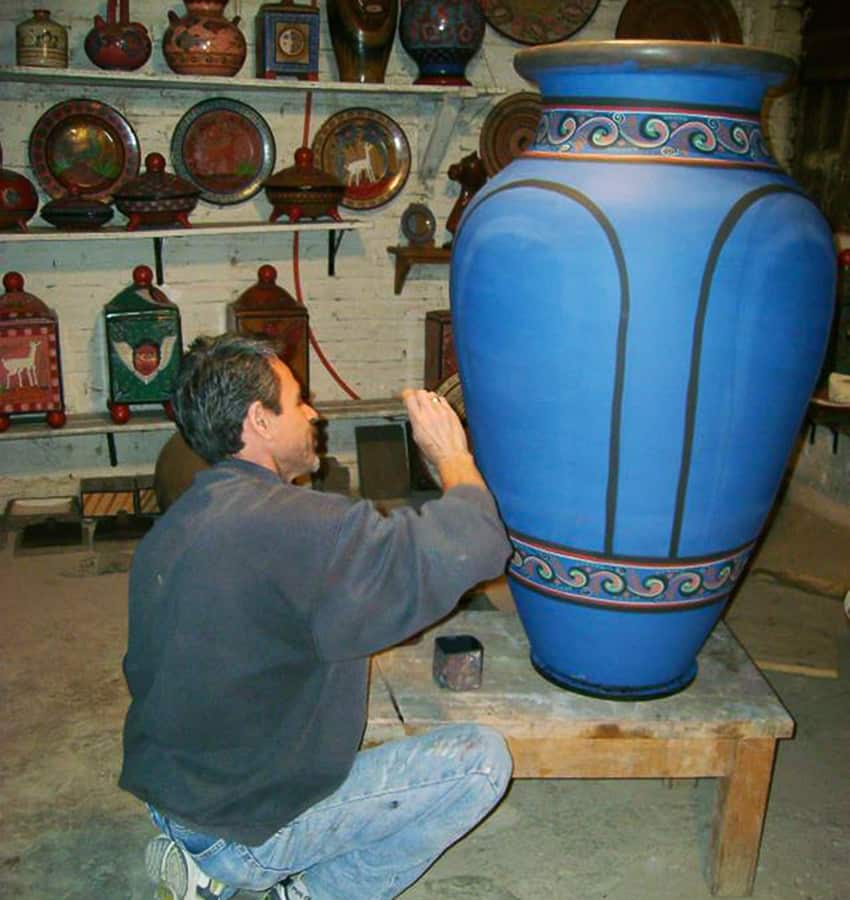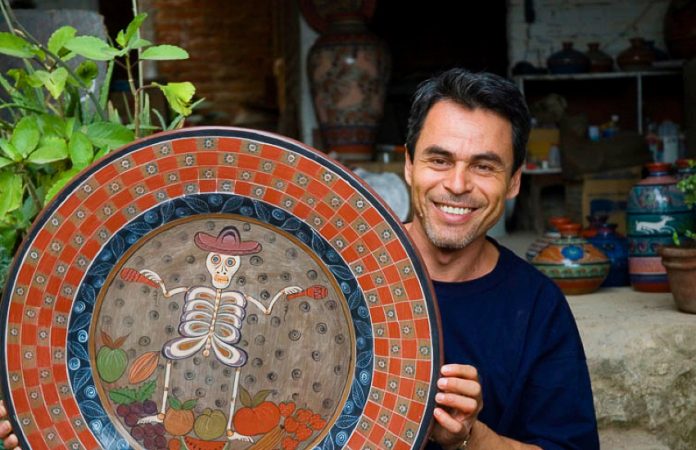José Luis Cortéz Hernández is one of the most prolific of Jalisco’s famous burnished potters of Tonalá. With a career of over three decades, he is an acknowledged master in his field.
That’s quite an accomplishment for an “outsider.” Tonalá burnished pottery has centuries of history; its secrets are jealously guarded by families with generations of experience.
The pottery is distinguished by the fact that, instead of being glazed, it is rubbed with a stone before firing to give it shine. More obvious are the traditional decorative motifs with highly stylized images of animals, plants and fantastical creatures called naguals.
But Cortéz is not from a family of potters. He was born to farmers in the village of San José de Gracia in the Los Altos region of the state. It is a whole other world, and burnished pottery is unknown there.
Looking for a better life, the family moved to Guadalajara when he was only six months old. He began working as a teen, eventually with a full-time job at a plastics factory in Tonalá.

His life changed when he needed to get a commemorative plate made for a couple celebrating their 50th wedding anniversary. He went to the workshop of Salvador Vázquez Carmona, a renowned artisan who not only was from a pottery family but also studied under maestro Jorge Wilmot, who established high-fire ceramics in Guadalajara.
When Cortéz arrived, the maestro was painting fine lines on a large platter.
“It was the moment when I got hooked because I was fascinated by the emerging image of a bird coming from the hands of the artisan,” he says.
Cortéz ordered the plate, picked it up and gave it to the couple, but he did not stop there. He returned again to the workshop to see if he could work there as an apprentice.
It was a brave thing to ask since Tonalá family workshops almost never take on outsiders; they prefer to keep their techniques a secret. Fortunately, Vázquez was more open-minded.
He told the young man that he could work for him, but Vázquez did not expect him to stay. It is hard work, and many who try don’t last a week. But Cortéz is made of sterner stuff and worked with the maestro for eight years.
Despite all that time, Cortéz says he really learned “only the basics” of molding and decorating. His road to becoming a master artisan would come through trial and error.
“I always focus on my kinds of pieces, wanting to make the next better than the last.” he says.
The basis of Cortéz’s work is traditional, especially the iconography that appears on his pieces — flowers, birds, other animals — because he believes it is important to preserve tradition; but he does add his own touches.
Cortéz’s work stands out because of the subtle changes he makes in both form and painting. He specializes in giant jars called tibores, platters, covered urns and other containers, the mainstays of Tonalá pottery.
Soon after leaving Vázquez’s workshop, Cortéz created his first innovation, squarish boxes, or “urns,” created by making the sides separately like tiles, then joining them together.
Another important innovation is the addition of traditional decorative elements in relief, created by making creatures like birds, fish and naguals in clay and attaching them to the main body of the piece. He likes the textural dimension that the relief gives.

His work has been regularly available in fine outlets in Guadalajara and other parts of Mexico and has been exhibited in the United States, France, Germany, Poland, the Netherlands, Japan and India. He has also had a longstanding relationship with the Feria Maestros del Arte, one of the most important folk art events in Mexico.
The connection with the Feria began about 14 years ago when a buyer offered to introduce him to the fair’s founder, Marianne Carlson. After seeing his work, she immediately offered him the chance to sell, and he has been a regular at the event ever since.
Carlson says that Cortéz “…has risen to become a true master of bruñido [burnished] pottery. His work won the National Ceramic Prize of Tlaquepaque in 2013.
Feria Maestros del Arte predicts a bright future for this creative artist whose face comes alive as he speaks of his craft. However, the maestro says that it is more satisfying to have people come into the workshop and appreciate the work that he does. Before the pandemic, he regularly had visitors from tours set up by local hotels, with some people staying for hours as they watched him work and explain his process.
The pandemic has prompted him to up his game online. He had a Facebook page but has recently launched a more thorough website. You can also order his work from the Feria’s web page.
Leigh Thelmadatter arrived in Mexico 18 years ago and fell in love with the land and the culture in particular its handcrafts and art. She is the author of Mexican Cartonería: Paper, Paste and Fiesta (Schiffer 2019). Her culture column appears regularly on Mexico News Daily.
